Cultivated widely across the globe for its ornamental blooms and edible roots, Salsify is considered an heirloom root vegetable with a long history and many culinary uses. The plant itself features decorative star-shaped purple flowers atop lime-green wiry stems with blue-green grass-like foliage to boot.
In this article, I will be detailing how you can grow and care for this beautiful wildflower in your garden as well as highlight the common uses for its roots, flowers and leaves in the kitchen so you can take full advantage of this long-lived root vegetable.
More...
Family: | Asteraceae |
|---|---|
Genus: | Tragopogon |
Species: | T. porrifolius |
Origin: | Southeast Europe and North Africa |
Common Names: | Salsify, vegetable oyster, purple salsify |
Location: | Outdoor |
Type: | Flowering root vegetable |
Growth: | Up to 1 metre tall, up to 40 centimetres wide |
Sun requirements: | Full to part shade (climate dependant) |
Foliage Colour: | Green |
Flower Colour: | Purple |
Flowering: | Spring to summer |
Edible Parts: | Produces edible roots in autumn |
Maintenance level: | Low |
Poisonous for pets: | Non-toxic to cats and dogs |
Introducing Salsify
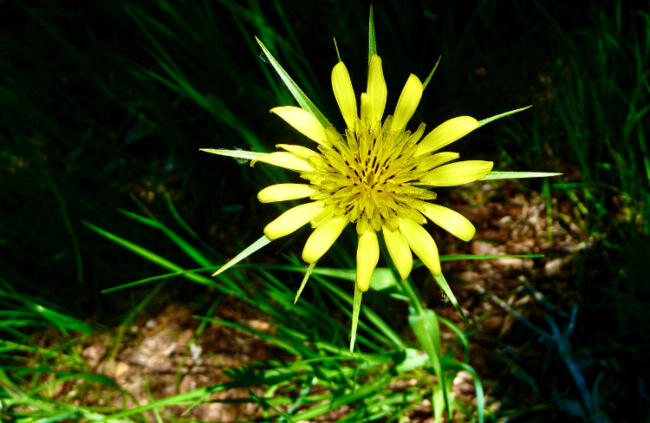
Despite being the most popular species in its genus, the roots are unusually hard to find in-store but luckily, the plant is easy to grow in your garden and is suitable for beginners and experts alike.
Enjoy eye-catching purple starry blooms, luscious blue-green foliage and nutritious root vegetables with this variable wildflower.
Salsify Plant Details
Botanically labelled Tragopogon porrifolius, this common and most notorious species is often referred to as salsify, vegetable oyster or purple salsify. Part of the Asteraceae family, the plant is native to southeast Europe and North Africa but is now widely introduced globally, predominantly in the British Isles, North America, southern Africa and Australia.
While there are no specific preferred climates zones for salsify, it is considered a cool climate vegetable and therefore does tend to perform best in cool to temperate climates.
The plant is a biennial wildflower and is slow-growing, typically reaching up to 1 metre tall and up to 40 centimetres wide in cultivation.
Popular Salsify Cultivars
- Salsify ‘White French’
- Salsify ‘Gian French’
- Salsify ‘Mammoth Sandwich Island’
Common Landscaping Applications
- Mass plantings
- Vegetable gardening
- Gap filling
- Cut flowers look gorgeous in bouquets
- Container gardening
How to Grow Salsify in Australia
This plant is best grown from seeds. Overall, it is grown very similarly to other root vegetables like parsnip and carrots so will require similar care and conditions. Seeds can typically be purchased online or at your local garden centre.
Alternatively, seeds can be collected from your plant after it goes to seed during its second year.
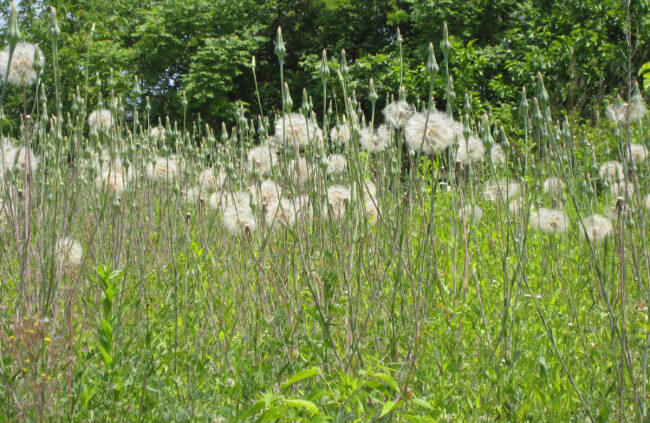
Growing Vegetable Oysters from Seed
- Sow seeds outdoors around early spring in the final growing site once the soil has started to warm up and frosts are unlikely.
- Transplanting should be avoided as the roots can easily be damaged.
- Choose a sunny spot with light and well-draining soil that is at least 30 cm deep.
- Remove stones from the soil and enrich with some compost or aged manure before sowing.
- Sow the fresh seeds thinly in shallow drills to a depth of about 2 cm with at least 30 to 60 centimetres in between rows. Seeds should be spaced about 3 cm apart.
- Water or sprinkle very lightly after sowing to avoid disrupting the seeds.
- Ideal temperatures for germination are around 8°C to 16°C.
- Germination can be slow and erratic so try to be patient. It can take 2 to 4 weeks for germination to successfully occur.
- Once seedlings are big enough to handle, you can thin them out to around 10 cm apart, removing the weaker specimens in the process.
- Seeds can be sown similarly into large containers outdoors that are at least 30 cm wide and deep, filled with a quality seed-raising mix and multi-purpose compost.
- From seed, plants will take about 120 days to reach a harvestable size.
Best Conditions for Planting for Salsify
Planting of seeds, seedlings or young plants should be done in early spring once temperatures have risen and the soil is warmer. While the ideal growing conditions are fairly basic, this plant will certainly look its best and produce better harvests given the most ideal conditions possible in your landscape.
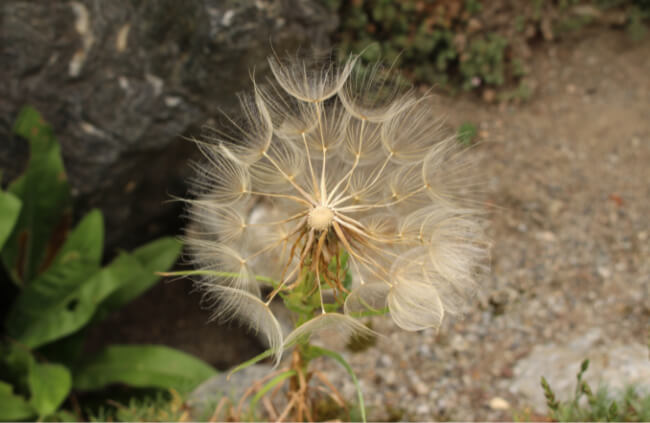
Ideal Soil Conditions
As this plant is mainly grown for its taproot (which normally reaches up to 30 cm in length), proper soil preparation is vital, especially if you’re looking to grow the largest roots possible.
Before planting, till and loosen your garden soil to a depth of about 30 cm. Remove any rocks and stones you find as they can quickly lead to deformed and damaged roots. Mix in some compost and aged manure as you till to enrich the soil and improve drainage.
In general, salsify will thrive in well-prepared and well-drained soil. It tends to prefer loam-based soil in gardens that can retain adequate moisture. As mentioned, the soil needs to be at least 30cm deep, light and loose for the roots to develop properly.
Avoid stoney and waterlogged soils. Ideal soil pH levels are between 6.0 and 6.8 so be sure to use a reliable pH meter to make sure your levels are adequate.
Lighting and Temperature Needs for Vegetable Oysters
Being a cool-season crop, this plant will thrive in full sun in cooler regions and part shade in temperate to warmer regions. In general, it should get at least 6 to 8 hours of bright daily light with some afternoon shade in warmer conditions.
If temperatures are too high, the crop will turn tough. Ideal growing temperatures are around 13°C and 24°C.
Spacing Purple Salsify
Plant or sow at a depth of about 2 cm. Space rows around 60 cm apart and seeds roughly 3 cm apart. Larger seedlings and plants should be spaced about 10 cm apart for the best results.
Companion Plants for Salsify
There are other fantastic plants and vegetables you can establish alongside your vegetable oyster plant. Popular companions include carrots, potatoes, lettuce, and parsnips.
Quick Tips for Growing in Containers
- Containers will need to be well-drained and at least over 30cm deep and wide for adequate root growth.
- It is recommended to use a quality potting medium and mix in some compost or aged manure when planting.
- Container-grown plants will still need proper light to thrive and may require more frequent pruning.
How to Care for Salsify
Once matured, plants can tolerate light frosts and temperatures down to about -1.5°C. Overall, these wildflowers require only basic care and are considered low-maintenance additions to most gardens.
Watering Needs
Once established, these plants will grow best with regular and consistent watering, especially during droughts. Proper watering will also improve the texture of the roots and prevent fibrous and stringy roots.
During the growing period in spring to summer, a good water supply will help to prevent the potential branching of the taproot. On average, aim to provide your plants with about 2 to 4 centimetres of water per week depending on conditions.
Mulching Vegetable Oyster
Add some organic mulch around seedlings after they germinate to help suppress weeds. As these plants are slow-growing, weeds can suffocate them so mulch will help with this.
Fertilising
While this plant does not require strong chemical supplementation, it will benefit from a mix of some compost or aged manure in the soil when planting then in summer, sided with a balanced organic fertiliser to support root and leaf development.
Pruning Needs
Regular and intense pruning is not required for this species. It is a slow-growing biennial so you will only need to remove spent flower heads and tip prune foliage as needed to maintain aesthetics.
How to Harvest and Use Salsify
While most of the Tragopogon porrifolius is edible, it is mainly prized for its edible and nutritious taproot. The roots and young shoots of the plant are versatile and are commonly eaten after being cooked, whether boiled, mashed, baked or roasted.
The freshly grown leaves can also be consumed cooked or raw but they hold little nutritional value versus other bush tuckers we have available. Salsify has been a popular cultivated vegetable since at least the 16th Century however it has declined in popularity in the more modern era.
Today, the roots are still cultivated frequently in France, Germany, Italy and Russia. The roots are said to have a mildly sweet, oyster-like flavour, hence the plant's common name. Roots will have a milder taste when uncooked, similar to asparagus or oysters.
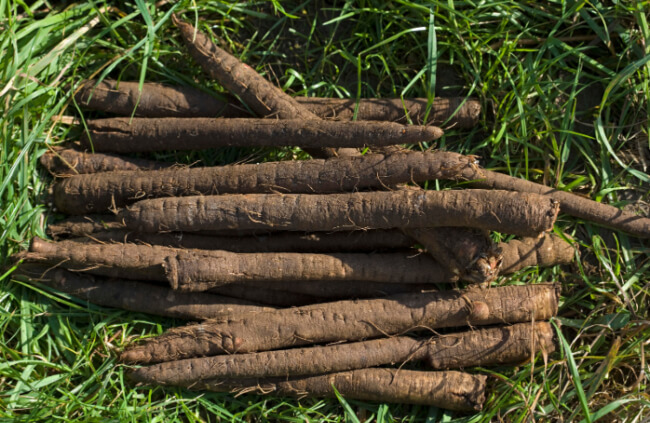
Salsify’s Nutritional Value
- Salsify’s macro breakdown is 77% water, 19% carbohydrates, 3% protein and about only 1% fat.
- Each 100 grams equates to around 82 calories (kcal).
- Micronutrients include vitamin B6, vitamin C, magnesium and phosphorus.
- The roots are considered a ‘cleansing food’, able to benefit the liver and gallbladder.
- The roots are also beneficial for maintaining healthy blood pressure.
Harvesting Salsify
- The taproots are typically harvested from late autumn onwards, after the frosts to improve the taste of the roots.
- The plants are usually ready for harvest about 100 to 120 days after planting. However, many gardeners choose to wait until the plant’s second year to harvest as the roots will naturally be far larger.
- Be sure not to wait for too long after flowering to harvest as the taproots can become stringy and inedible.
- The creamy-white roots are usually harvested during the first or second year of growth
- Gently loosen the soil around the roots to dig up the plants.
- Then, gently lift plants from the soil when harvesting as the roots are susceptible to damage or even breaks.
- Shake off excess soil then rinse the roots off with some water and lemon juice to prevent oxidation.
How to Use Salsify
- Scrape the outer layer of skin off the roots then submerge them into some cold water.
- It is recommended to boil the roots as this will soften them while also increasing the potency of their flavours.
- Raw young roots can be grated into different salads but older roots are best enjoyed cooked.
- Cooked roots can be used to flavour soups, stews, stir-fries and many other dishes.
- Add some potato to your roots and puree for a delicious salsify puree perfect for fish-based dishes.
- Young flowers and fresh leaves can be used like asparagus, either raw or cooked, to be added to salads and other fresh dishes.
Storage Instructions
To store roots, it is best to refrigerate them at about 0°C at a 90-95% relative humidity where they should keep for 2 to 4 months.
Salsify Pests and Diseases
There are thankfully few pest and disease issues that plague this species as it is naturally quite resistant to most pests and diseases. However, there are a few exceptions.
White Rust
Also known as Albugo tragopogonis, white rust is perhaps the most common disease that affects this species and its genus. It will start as white spotting on leaves and stems and lead to more severe white blisters over time.
Mulching with oats tends to help reduce the number of fungi infecting seedlings and roots. You can treat this fungal disease similarly to powdery mildew by spraying the plants with a frequent dose of an organic horticultural spray or an organic neem oil spray.
Wireworms
Also known as click beetles or darkling beetles, wireworms are small brown worms that look similar to mealworms. They can riddle your crops with holes and lead to plants looking deflated and unhealthy.
To avoid wireworm infestations, you should rotate your crops and till your garden soil prior to planting to reduce active wireworm populations.
Winter Pests
If you leave your roots in the ground over winter, larger pests like mice and moles may enjoy nibbling them.
Salsify Frequently Asked Questions
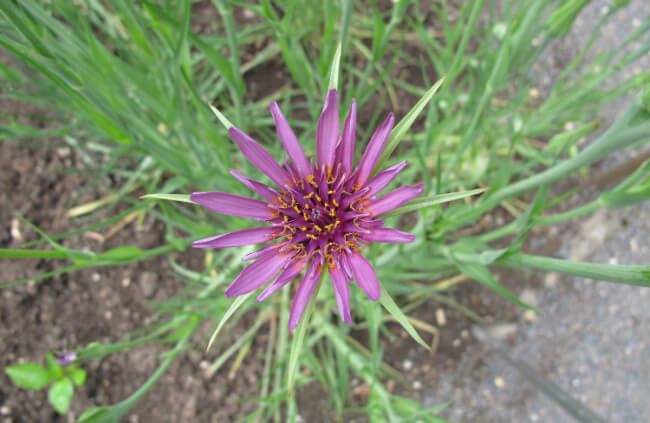
What does salsify taste like?
The large pencil-like taproots are best enjoyed cooked where they feature a slightly sweet, oyster-like flavour profile. Some say they also taste similar to artichokes.
What is salsify good for?
This root vegetable has many beneficial health-supporting properties including a boost to your immunity, better blood pressure and hair growth and more production of bifidobacterial cells.
Does salsify like sun or shade?
In most conditions, full sun is certainly preferable. If you live in an area where the sun is too harsh for this cool season vegetable, then planting in partial shade is recommended where the plants can get some afternoon shade.
What country did salsify originate from?
The vegetable was first cultivated in Italy and France in the 16th Century. It is still quite popular in those countries today.
Can you eat salsify raw?
This incredibly versatile root vegetable can be served raw or cooked. Raw roots do tend to have a milder taste with a firmer texture so many prefer boiling it to soften the roots and enhance the natural flavours.
Does Salsify give you gas?
As the roots do contain high doses of levulin, they may cause gas in people unaccustomed to eating it, especially when consumed raw.
Interested in growing other popular root vegetables at home? Be sure to check out some of our other in-depth guides below for more useful information:
Enjoy a Succulent Heirloom Root Vegetable and Start Growing Salsify Today
Well, there you have it, one of the most popular introduced root vegetables we have the privilege of growing here in Australia, Salsify. As you can see, there’s little not to like about this spectacular species.
Whether for its ornamental purple starry flowers, its lush blue-green foliage or its nutritious taproots, this plant has a lot to offer both gardens and gardeners. Start enjoying succulent heirloom root vegetables in your garden and kitchen with the special Salsify plants.
Published on July 22, 2023 by Maisie Blevins
Last Updated on February 24, 2024




